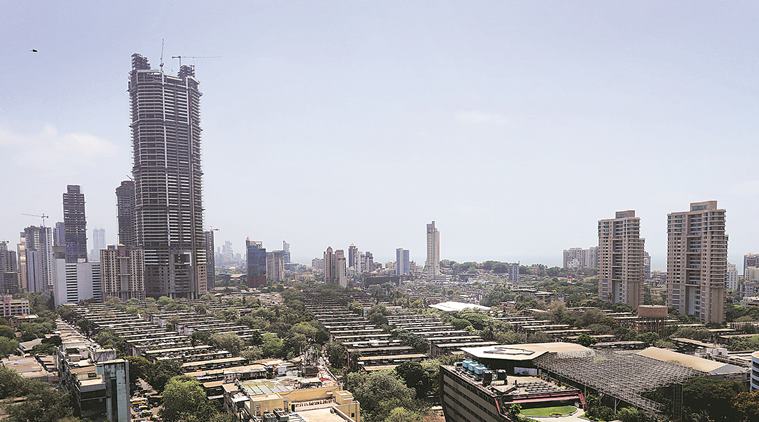Stay updated with the latest - Click here to follow us on Instagram
Mumbai: State government set to lift FSI cap on slum clusters
Slum developers are also set to benefit from higher saleable area incentives for redeveloping slum pockets situated in non-prime areas of the city.
 While failing to meet the objective of making Mumbai slum-free, slum redevelopment projects have already turned into a goldmine for realtors. (File)
While failing to meet the objective of making Mumbai slum-free, slum redevelopment projects have already turned into a goldmine for realtors. (File)
Redevelopment of Mumbai’s densely populated slum colonies just got more lucrative for the construction industry. Dishing out new perks for slum developers, the Devendra Fadnavis government has decided to lift the curb on permissible built-up area on slum plot.
While a builder redeveloping a slum cluster in Mumbai was permitted to construct up to three times the plot size, the state government, which is in the final stages of approving the extended part of the city’s new development control regulations, has decided to withdraw the upper cap on the floor space index (FSI) permissible for a slum plot.
FSI is a development tool that defines the extent of construction permissible on a plot. It is the ratio of the built-up area of the plot to the plot area.
In simple terms, this means that if a realtor could earlier build up to 6,000 square metres on a 2,000 square metre slum plot, decks are now being cleared for him to construct more on the plot.
Town planners fear this would further burden the city’s infrastructure and lead to further densification of slum plots. Mumbai’s latest land use survey, which was published as part of the city’s new draft development plan, had found that Mumbai’s slum clusters had the highest population densities in the city. According to the survey report, Mumbai’s slum population — currently estimated to be about 52 lakh — occupies barely eight per cent of the city’s geographical area. “Permitting more construction will only increase such densities further,” said a government town planner, requesting anonymity.
While failing to meet the objective of making Mumbai slum-free, slum redevelopment projects have already turned into a goldmine for realtors.
But justifying the move, a senior government official said that the lifting of the cap would make several ongoing redevelopment projects, which had been delayed, more viable.
In May, Chief Minister Devendra Fadnavis, while sanctioning the published draft of new development plan, had enhanced the FSI cap from 3 to 4 for all slum redevelopment projects. Prevalent norms permit the SRA to sanction an FSI of 4 only for slum clusters where the tenement density was more than 650 per hectare. But before the new development plan even kicks in, the government has diluted the norm further, withdrawing the cap entirely.
Slum developers are also set to benefit from higher saleable area incentives for redeveloping slum pockets situated in non-prime areas of the city. Replicating the cluster redevelopment approach adopted for redevelopment of dilapidated cessed buildings in the island city, the government has decided to adopt a variable incentive model for slum projects.
“On the lines of the cluster redevelopment model, the incentive FSI admissible against the FSI required for rehabilitation will now be based on the ratio of the land rate of the slum plot and the rate of construction as per government’s norms,” an official said.
In other words, higher sale incentives will be available for developing slum pockets located in areas with moderate or low land rates. At present a developer can avail anywhere between 75 per cent and 100 per cent of the FSI required for rehabilitation as the incentive area. At present in exceptional cases for ‘difficult’ areas where the slum densities are very high, saleable area up to 133 per cent of the rehabilitation component in permitted. While the draft new development plan had done away with the ‘difficult’ area incentive norm, the government has found a way to reintroduce it. Sources said that based on the land rate to the construction cost ratio, developers could avail anywhere between 80 per cent and 133 per cent incentive.
But, while permitting higher construction in slum pockets, sources said that the government won’t permit any relaxation in open space margin norms.
Giving up land for public use to be rewarded
Sweetening the deal for land owners and societies whose plots or portions of these are reserved for buildable public amenities, the city’s new development plan will allow the built-up area used for development of the amenities to be fully compensated in the form of the incentive FSI.
The perk will be extended over and above the permissible FSI, implying that participating land owners and societies can now avail higher construction rights than normally permissible if they build such amenities and hand them over to the public.
Faced with paucity of funds, the Mumbai municipality relies heavily on the principle of accommodation reservation, where affected land owners or societies develop these and are compensated in terms of the FSI or transferable development rights. (Express News Service)







